| Bermuda Police Service | |
|---|---|
 Badge of the Bermuda Police Service | |
 Flag of Bermuda | |
| Agency overview | |
| Formed | 1879 |
| Jurisdictional structure | |
| Operations jurisdiction | Bermuda |
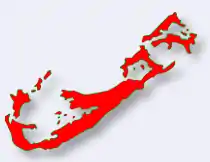 | |
| Bermuda Police Service area | |
| Size | 53 square kilometres (20 sq mi) |
| Population | 66,000 |
| General nature | |
| Operational structure | |
| Headquarters | Hamilton |
| Sworn members | 468 |
| Agency executive |
|
| Facilities | |
| Stations | 4 |
| Website | |
| www | |
The Bermuda Police Service is the law enforcement agency of the British Overseas Territory and former Imperial fortress of Bermuda. It is responsible for policing the entire archipelago, including incorporated municipalities, and the surrounding waters. It is part of, and entirely funded by, the Government of Bermuda. Like the Royal Bermuda Regiment, it is under the nominal control of the territory's Governor and Commander in Chief, although, for day-to-day purposes, control is delegated to a minister of the local government. It was created in 1879, as Bermuda's first professional police service. In organisation, operation, and dress, it was created and has developed in line with the patterns established by British police services, such as the City of Glasgow Police, and the Metropolitan Police Service.
History of law enforcement in Bermuda



Bermuda's first police, from settlement until 1879, had been nine parish constables (one for each parish). As had been the case in England, these positions were filled by men appointed for twelve months, unpaid service, until pay was introduced in the 19th century. These appointments were compulsory, akin to jury service.
Dissatisfaction with the quality of this part-time constabulary led to the formation of the Bermuda Police Force under the Police Establishment Act, 1879. The new body consisted of ten full-time constables under Superintendent J. C. B. Clarke. Three of the constables were based in Hamilton, with Clarke, three in St. George's, with Chief Constable H. Dunkley, and two in Somerset, and there were still twenty-one part-time parish constables.
The size of the police force was trebled in 1901. The first detective was appointed in 1919, and the force was reorganised again in 1920, with eighteen constables recruited from the UK raising its strength to forty-six. The size of the force grew steadily over the following decades.
The Bermuda Reserve Constabulary was created in 1951. After the reduction of Bermuda's Royal Naval Dockyard (which had had its own police force) to a base in 1951, and the associated withdrawal of regular British Army units of the Bermuda Garrison in 1957 (leaving only part-time units), Police Headquarters and other elements relocated to Prospect Camp, the former military headquarters. A Women's Department was established in 1961 with the first five female police officers. A marine section was formed in 1962, with its first large boat, the Heron, being built by police officers in their spare time.
Internal security
In the 1960s the Bermuda Police performed a new role: internal security, dealing with riots resulting from the struggle for racial equality. This culminated in 1977 with riots following the hanging of two members of the Black Beret Cadre convicted of five murders, including those of Governor Richard Sharples, his aide-de-camp Captain Hugh Sayers, and the Commissioner of Police George Duckett. The death penalty had not been used in Bermuda for three decades. As the two men convicted were black, many blacks saw the death sentences as racially motivated.
Renaming as Bermuda Police Service

In 1995 the Bermuda Police Force was renamed the "Bermuda Police Service" as it was thought that the word "force" had unsavoury connotations. The Reserve Constabulary was renamed the "Bermuda Reserve Police"[1][2] and adopted the same uniform as the full-time police officers. This was meant to address the common misconception they had suffered from, which was that they were not "real" police officers. Also in 1995, the United States Navy withdrew from Bermuda, leaving the Bermuda Government responsible for policing the whole of what was now Bermuda International Airport.
Bermuda was still feeling the effects of the recession of the early 1990s, and this had led to a reduction in the number of officers of the Bermuda Police Service. At the same time, the new Police Commissioner, Colin Coxall,[3] was determined to modernise the Bermuda Police Service by returning it to its roots.[4] It was felt that the service had lost familiarity with the community it was policing, with constables waiting in police stations to react to situations, rather than walking the beat, anticipating, and preventing them.
As the Bermuda Police Service attempted to redirect its efforts to more traditional "community policing", which required more officers, it found itself short of personnel. Many non-policing roles within the service were reassigned to civilians in order to place more police officers on the street, but it was ultimately decided to withdraw most of the detachment from the airport in order to make-up the shortfall elsewhere.
Airport police
After the 1995 closure of the US Navy's NAS Bermuda, policing of the airport, which had previously been split between the US Navy and the Bermuda Police, was divided between the new Airport Security Police (a privatised police force operating under the Department of Airport Operations - part of the Ministry of Transport), on the airside, and the Bermuda Police Service, which maintained a small detachment at its Airport Police Station, supplied from the complement of the St. George's Police Station, on the landside. That part of the former US Naval Air Station Bermuda which was not required for the operation of the airfield was fenced off and patrolled, until final decisions on the disposal of the land were made, by the Baselands Security. This was a unit of security guards recruited, trained, and operated by the Bermuda Police Service, which wore Bermuda Police uniforms, drove Bermuda Police cars, but whose personnel were civilians, without police powers.
Current operations
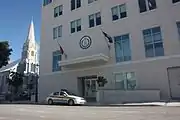
As of 2009, the strength of the service is 468 officers, operating from four police stations in Hamilton, St. George's, Southside (the former US Naval Air Station) and Somerset, along with the headquarters at Prospect Camp, and a small Marine Police Station on Barr's Bay, in Hamilton (which had been shared with the US Navy's Shore Patrol up until 1995. This has now been moved to the Royal Naval Dockyard). Following the closure of the US Naval Air Station in Bermuda, the Scenes Of Crimes officers have moved to a building there. Plans to create a single, new building to house both the Hamilton Police Station and the Magistrates Court on the corner of Court Street and Victoria Street have recently been carried through, with the Hamilton Police Station having relocated there. Sub police stations on Ord Road, in Warwick, and on St. David's Island have been discussed, though not opened. As with the Airport Police Station, these stations would be staffed only for parts of the day by detachments from one of the permanent stations. Such a sub station was actually created on Middle Road, in Warwick, a few years ago, but has since been closed.
Following a spate of shootings in May, 2009, believed to be gang-related, there were calls for increasing the size and deployment of police forces. Premier Ewart Brown called for "sustained, regular policing" and increased foot patrols "in recognised trouble spots".[5][6][7] Police Commissioner Jackson said on 29 May that the Service faced "an unprecedented level of criminality" from a hardcore group of 50–100 violent individuals in four or five gangs. In response, the force will intensify patrolling of trouble-prone areas, by doubling the number of Armed Response Vehicles and deploying officers on an around-the-clock basis in those areas.[8]
The Royal Bermuda Regiment Coast Guard takes control of any Maritime Law Enforcement and Search & Rescue duties.[9][10]
Most of the boats used by the Bermuda Police are too small to be used far from shore. As Bermuda is now responsible for policing a zone within a 200-mile radius of Bermuda, larger, seagoing vessels are required. The first large boat operated by the unit, the Heron, lacked the speed required to quickly respond to incidents beyond the reefline. The unit had subsequently also utilised sport fishing boats, including the Heron II, but took delivery in 2006 of a purpose-built patrol vessel, the Guardian, built by Australian shipyard Austal.[11][12]
Rank Structure
The rank structure of the Bermuda Police Service is similar to British police forces and starts with the most junior rank of Constable and goes up to Commissioner.
The Commissioner is often an experienced British police officer, but in October 2021, a local Bermudian and career BPS Police Officer was made Acting Commissioner.[13][14]
| Bermuda Police Service Ranks and Insignia | |||||||||
|---|---|---|---|---|---|---|---|---|---|
| Rank | Commissioner | Deputy Commissioner | Assistant Commissioner | Superintendent | Chief inspector | Inspector | Sergeant | Constable | |
| Epaulette insignia |  |
This rank has two pips above the wreath, one more than AC |  |
 |
 |
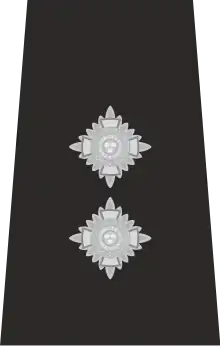 |
 |
 | |
Reserve police
The BPS has a reserve force, created as the Bermuda Reserve Constabulary in 1951, which was renamed as the Bermuda Reserve Police in 1999 (the change also included issuing the reservists the same dark blue uniform as the regular constabulary as some members of the public had imagined the previously grey-uniformed reservists to not be "real police").[15][16]
Prior to 1951, the Parish Constables had originally been retained to supplement the new regular Police Constables (today, Parish Constable is an appointment held by a regular Police Constable). Extra Constables (at least some of whom were retired Police Constables) were appointed when required to support the Police Constables and Rural Police Constables, including during the First World War.[17] The Bermuda Special Constabulary had been created during the Second World War, but had been disestablished in 1950.[18][19]
The Reserve is made up of men and women between the ages of 18 and 60, who have full powers, including the power of arrest.[20]
They are unpaid officers, similar to the United Kingdom's Special Constabulary. However, they do receive a tax-free sum every six months.[21]
Rank structure
The Reserve Police have their own distinct rank structure, which is one of the ways of distinguishing the more senior Reserve ranks from Regular ranks.[22] The rank structure was altered in 2015.[23]
The insignia is similar to some UK Special Constabulary rank structures, in that it does not uses the 'pips and crowns' system, but rather bars and laurel wreaths. Reserve Constables wear no insignia, just their collar number, like their regular counterparts.[24]
| Bermuda Reserve Police Rank Structure | |||||||||
|---|---|---|---|---|---|---|---|---|---|
| Rank | Commandant | Deputy Commandant | Assistant Commandant | Chief Officer | Section Officer | Reserve Constable | |||
| Epaulette
insignia |
 |
 |
 |
 |
 | ||||
Equipment
The current equipment of Bermuda Police consists of ASP telescopic batons for regular duty and Arnold 26-inch batons for crowd and riot control, as well as PAVA spray, Tasers, ARWEN 37 launchers, and tear gas and smoke grenades.[25] Firearms available include Glock 17 9mm handguns, Heckler & Koch MP5 9mm submachine guns, M16 and M4 assault rifles, and Remington 12 gauge shotguns.[26]
Gallery
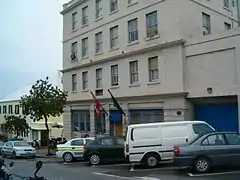 The former Hamilton police station in 2006
The former Hamilton police station in 2006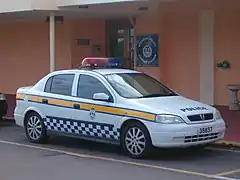 BPS patrol car at the Airport Station
BPS patrol car at the Airport Station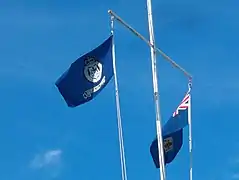 Flags of the marine section at Barr's Bay
Flags of the marine section at Barr's Bay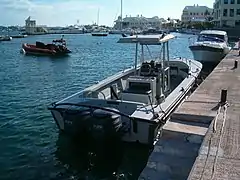 Boats of the marine section at Barr's Bay, in Hamilton
Boats of the marine section at Barr's Bay, in Hamilton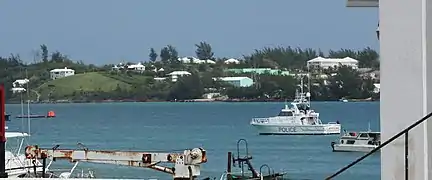 The Guardian patrolling St. George's Harbour, in July 2011
The Guardian patrolling St. George's Harbour, in July 2011 Royal Bermuda Regiment & BPS boats in July 2011
Royal Bermuda Regiment & BPS boats in July 2011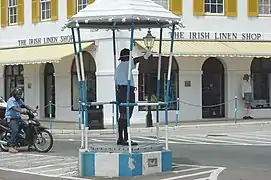 Policeman directing traffic from the Birdcage at Heyl's Corner, on Front Street in Hamilton, 2001
Policeman directing traffic from the Birdcage at Heyl's Corner, on Front Street in Hamilton, 2001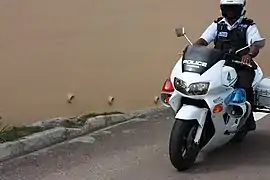 A police sergeant of the cycle squad in July, 2011
A police sergeant of the cycle squad in July, 2011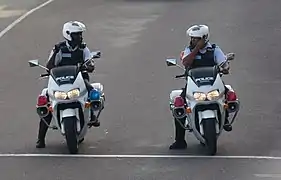 BPS motorcyclists
BPS motorcyclists
References
- ↑ Keith A. Forbes (9 September 2006). "Bermuda's History from 1900 to 1999". Bermuda Online. Archived from the original on 7 October 2006. Retrieved 10 September 2006.
- ↑ Keith A. Forbes (2013). "Bermuda Reserve Police: History of the Reserve Police". Bermuda Police Service. Bermuda Police Service. Retrieved 31 July 2023.
Following the March 1995 appointment of Mr. Colin Coxall as Commissioner of Police, the Reserve Executive Committee made a fresh appeal to the new Commissioner for a change of name, to which he agreed. The Reserves also adopted a new uniform, which is practically identical to that worn by their full time counterparts. Henceforth they would no longer be known as the Reserve Constabulary, but as the Bermuda Reserve Police. Interestingly at the same time, the regular Force changed their name from the Bermuda Police Force to the Bermuda Police Service.
- ↑ "House of Commons Hansard Debates for 26 Jan 1995". Archived from the original on 30 September 2007. Retrieved 22 August 2007.
- ↑ "Welcome to the BPS website". www.bermudapolice.bm.
- ↑ Burgess, Patrick & Dale, Amanda (23 May 2009). "Police name shooting victim; three more men shot this morning". The Royal Gazette. Retrieved 27 May 2009.
- ↑ "Premier calls for increased Policing in trouble spots". The Royal Gazette. 26 May 2009. Retrieved 27 May 2009.
- ↑ Dale, Amanda (27 May 2009). "Premier calls for more community beat officers, armed units". The Royal Gazette. Retrieved 27 May 2009.
- ↑ Dale, Amanda (29 May 2009). "Police: At least 100 youths in four or five gangs". The Royal Gazette. Retrieved 29 May 2009.
- ↑ Simons, Duncan. "RBR Go to Sea in Security Role - Royal Bermuda Regiment". www.bermudaregiment.bm. Retrieved 26 March 2022.
- ↑ Bell, Jonathan (9 February 2021). "RBR takes operational control of Coastguard service". The Royal Gazette. Retrieved 26 March 2022.
- ↑ "Marinelog: Bermuda Marine Police Unit has a new Guardian.".
- ↑ Bermuda Police 16M - Austal Archived 2 April 2015 at the Wayback Machine
- ↑ "Welcome to the BPS website | Senior Management Team".
- ↑ "Corbishley resigns as police commissioner". 2 October 2021.
- ↑ "Today in Bermuda's history". The Royal Gazette. City of Hamilton, Pembroke, Bermuda. Retrieved 11 June 2022.
In 1999, the Bermuda Police Force/Bermuda Reserve Constabulary changed its name to the Bermuda Police Service/Reserve Police.
- ↑ "Police Reserves looking for a few good men or women". The Royal Gazette. City of Hamilton, Pembroke, Bermuda. Retrieved 11 June 2022.
The Reserve HQ at Prospect was upgraded last year and the part-time service is also in the process of officially changing its name -- dropping the old title of Constabulary in favour of Police. Commandant Moore, a Reservist for more than 25 years, said: It's all designed to bring the Reserve Police into line with the current strategy of the Police Service. It's all part and parcel -- the change of uniform was for the same reason.
- ↑ "MARTIAL LAW REGULATIONS". The Royal Gazette. City of Hamilton, Pembroke, Bermuda. 6 August 1914. p. 2.
GOVERNMENT NOTICES: A Proclamation!... MARTIAL LAW REGULATIONS. 24. All persons having in their possession, custody or control any firearms of any description are required to deliver them forthwith to some Police Constable, Rural Police Constable or Extra Police Constable. This Regulation shall not apply to any person of His Majesty's Naval or Military Service... His Excellency the Officer Administering the Government having proclaimed that a state of war exists between the United Kingdom of Great Britain and Ireland and Germany and His Excellency having further proclaimed martial law in these Islands, the following persons are hereby required to serve as extra constables, and are commanded to present themselves forthwith to the nearest Justice of the Peace for the purpose of taking the necessary oaths, and for receiving instructions, and this notice shall be authority for any Justice of the Peace to swear in as extra constables the persons named hereunder. The persons named hereunder in the parishes of Pembroke, St. George's, Somerset, and in the Island of St. David's shall, after taking the oaths as extra constables, forthwith report themselves at the police stations at Hamilton, St. George's, and Somerset. Any person named hereunder failing to comply promptly with the orders contained in the notice will be subject to be dealt with under the provisions of the Army Act. LIST OF EXTRA CONSTABLES. SANDYS. James Barritt Young. Field Astwood Ingham James Robert Finlay Richard Mackey George Down Bernard E. Mackay. SOUTHAMPTON. Wyndham A. H. Barnes George W. Hill Kempe George White William B.Ingham Isaac M. Hall Reginald Ingham WARWICK. Elwyn Ward Dudley Conyers George S. Powell Greig B. Whitney Stephen E. Tucker Edward C. Adams. PAGET. Benjamin Harriott Charles Leseur George Leseur Augustus Simons Edward C. Barnes Thomas H. Doe. PEMBROKE. Stanley Paschal George Tear Ainsley Vallis William H. Jackson Nicholas E. Lusher Edmund Goldie North. DEVONSHIRE. George Winter Richard W. Browne E. Leslie Adams William A. Smellie W. Clarence James E. G. Gibbons. SMITHS. B. C. C. Outerbridge Spencer Joell W. R. Lightbourn Matthew Ritchie Smith George Smith Walter W. McRonald. HAMILTON. Henry T. North Thomas Davis Stephen Wilkinson George R. Outerbridge G. Harold Outerbridge T. Wickwire Davis. ST. GeEORGE'S. Frank Duerden Vaughan Pugh Territt Tucker Higinbothom Frederick Collins Outerbridge Robert Oliver Clifford Edward Healy. ST. DAVID'S ISLAND. Thomas Fox Austin Lamb Edgar Hayward Frank Redmond. By His Excellency's Command, R. POPHAM LOBB, Colonial Secretary. 4th August, 1914.
- ↑ "We're committed to service". The Royal Gazette. City of Hamilton, Pembroke, Bermuda. Retrieved 11 June 2022.
According to its present Commandant, John Moore, the Bermuda Reserve Police was established in the early part of the 1940's, sometime during World War II. It was known in those days as the Bermuda Special Constabulary, he said, but that organisation finished in 1950. The Bermuda Reserve Constabulary actually started in 1951.
- ↑ Wilcox, Sergeant Chris (2013). "Bermuda Police History - The Years Of Change 1930-1979: AFTER THE WAR; Into the 1950's". Bermuda Police Service. Bermuda Police Service. Retrieved 11 June 2022.
1951 also saw the establishment of the Bermuda Reserve Constabulary, although actual recruiting did not begin until the following year.
- ↑ "Welcome to the BPS website | Join the Reserves".
- ↑ "Welcome to the BPS website | Join the Reserves".
- ↑ "Welcome to the BPS website | Change of Bermuda Reserve Police Ranks and Insignia".
- ↑ "Welcome to the BPS website | Change of Bermuda Reserve Police Ranks and Insignia".
- ↑ "Welcome to the BPS website | Change of Bermuda Reserve Police Ranks and Insignia".
- ↑ "Police to Start Carrying Tasers This Week". Bernews. 21 April 2010. Retrieved 26 March 2022.
- ↑ Burchall, Larry (10 June 2010). "Police Weapons: Tasers, Guns, Grenades & More". Bernews. Retrieved 26 March 2022.
External links
- Official website
- "The late Mr. George Tear". The Royal Gazette. 13 April 1915.
- POTSI (archived): Period photographs of the Bermuda Police

.svg.png.webp)